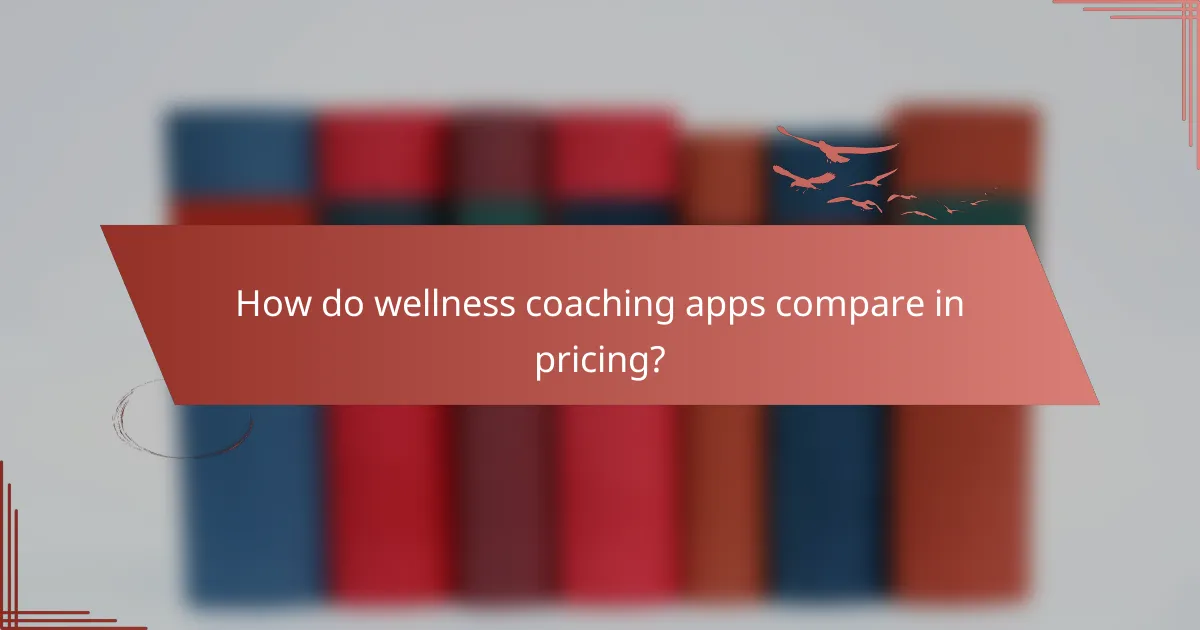Wellness coaching apps are designed to empower users in tracking their health and fitness goals through effective progress monitoring tools. By offering tailored support and engaging features, these apps enhance user experience and motivation on the journey to improved wellness. Additionally, seamless integrations with fitness trackers and health platforms allow users to consolidate their data, making it easier to share achievements and stay on track.
![]()
What are the best wellness coaching apps for progress tracking?
The best wellness coaching apps for progress tracking provide users with tools to monitor their health and fitness goals effectively. These apps typically include features for logging activities, tracking nutrition, and analyzing progress over time.
MyFitnessPal
MyFitnessPal is a popular app that focuses on nutrition and calorie tracking. Users can log their meals and exercise, making it easier to see how their daily habits affect their wellness goals. The app offers a vast database of foods, allowing for quick entry and accurate tracking.
One of its key features is the ability to set personalized goals based on weight loss or maintenance. Users can also connect with friends for motivation and support, enhancing the overall experience.
Noom
Noom combines wellness coaching with psychological principles to help users change their habits. The app provides daily lessons and personalized coaching, focusing on behavior change rather than just calorie counting. This approach can lead to more sustainable results.
Users can track their food intake and physical activity while receiving feedback and encouragement from a coach. Noom’s emphasis on understanding the psychological aspects of eating can be particularly beneficial for long-term success.
LifeSum
LifeSum offers a comprehensive approach to wellness with features for tracking food, exercise, and hydration. The app allows users to set specific goals, such as weight loss or muscle gain, and provides meal plans tailored to those objectives. Its user-friendly interface makes logging easy and engaging.
Additionally, LifeSum includes a barcode scanner for quick food entry and offers insights into nutritional intake. This can help users make informed choices about their diets.
Fitbit
Fitbit is well-known for its fitness tracking devices, but its app also excels in wellness coaching. Users can track their physical activity, sleep patterns, and heart rate, providing a comprehensive view of their health. The app syncs with Fitbit devices for real-time data.
Fitbit encourages users to set daily activity goals and offers challenges to keep motivation high. The integration of health metrics can help users understand how their lifestyle choices impact their overall wellness.
Headspace
Headspace primarily focuses on mental wellness through mindfulness and meditation. While it may not track physical progress like other apps, it plays a crucial role in overall wellness by promoting mental clarity and stress reduction. Users can choose from various guided meditations tailored to different needs.
Headspace also includes features for tracking meditation habits, allowing users to see their progress over time. This can enhance motivation and commitment to a regular mindfulness practice.

How do wellness coaching apps enhance user experience?
Wellness coaching apps enhance user experience by providing tailored support, engaging features, and intuitive designs that cater to individual needs. These elements work together to motivate users and facilitate their journey toward better health and wellness.
Personalized feedback
Personalized feedback is crucial in wellness coaching apps as it helps users understand their progress and areas for improvement. By analyzing user data, these apps can offer insights tailored to individual goals, such as weight loss or stress management. For example, an app might suggest specific exercises or dietary changes based on a user’s activity levels and preferences.
To maximize the benefits of personalized feedback, users should regularly update their goals and input relevant data. This ensures that the app’s recommendations remain aligned with their evolving wellness journey.
Gamification elements
Gamification elements, such as points, badges, and challenges, significantly enhance user engagement in wellness coaching apps. These features create a fun and competitive atmosphere, encouraging users to stay committed to their health goals. For instance, users might earn rewards for completing daily workouts or achieving milestones, which can boost motivation.
However, it’s essential for users to choose apps that balance gamification with genuine progress tracking. Overemphasis on rewards can sometimes distract from the primary goal of improving health and wellness.
User-friendly interfaces
User-friendly interfaces are vital for ensuring that wellness coaching apps are accessible and easy to navigate. A clean design with clear menus and intuitive features allows users to focus on their wellness journey without frustration. For example, apps that use simple icons and straightforward instructions can help users quickly find the information they need.
When selecting a wellness coaching app, users should look for one that offers a seamless experience across devices, whether on smartphones or tablets. This ensures that they can track their progress and access resources anytime, anywhere, enhancing their overall experience.

What integrations do wellness coaching apps offer?
Wellness coaching apps typically offer integrations with various platforms to enhance user experience and track progress effectively. These integrations can include fitness trackers, health apps, and social media, allowing users to consolidate their wellness data and share achievements.
Integration with fitness trackers
Wellness coaching apps often integrate with popular fitness trackers like Fitbit, Garmin, and Apple Watch. This integration allows users to automatically sync their physical activity data, such as steps taken, calories burned, and heart rate, directly into the app.
When selecting a wellness app, consider how well it connects with your existing fitness tracker. Look for apps that support multiple devices to ensure compatibility and maximize your tracking capabilities.
Integration with health apps
Many wellness coaching apps can connect with health apps like Apple Health and Google Fit. This integration enables users to import health metrics such as sleep patterns, nutrition data, and biometric information, providing a comprehensive view of their wellness journey.
To make the most of these integrations, ensure that the wellness app you choose can pull data from your preferred health apps. This will streamline your tracking process and help you make more informed decisions about your health and wellness.
Integration with social media
Social media integration allows users to share their wellness milestones and achievements with friends and followers on platforms like Facebook, Instagram, and Twitter. This feature can enhance motivation and accountability by fostering a community of support.
When using social media features, be mindful of privacy settings and the information you choose to share. Opt for apps that allow you to control what is visible to others, ensuring your personal data remains secure while you enjoy the benefits of social engagement.

What features should you look for in a wellness coaching app?
When selecting a wellness coaching app, prioritize features that enhance your experience and support your health goals. Key elements include progress tracking, community support, and customizable coaching plans, all of which contribute to a more effective and engaging wellness journey.
Progress tracking capabilities
Progress tracking is essential for monitoring your wellness journey. Look for apps that allow you to log various metrics such as weight, exercise frequency, and dietary habits. The best apps provide visual representations, like graphs or charts, to help you easily see your progress over time.
Consider apps that offer reminders and notifications to keep you accountable. Some may even integrate with wearable devices, allowing for automatic data syncing, which can simplify the tracking process and enhance accuracy.
Community support features
Community support features can significantly enhance your motivation and commitment. Many wellness apps include forums or chat groups where users can share their experiences, challenges, and successes. This social interaction fosters a sense of belonging and encouragement.
Look for apps that facilitate group challenges or events, as these can create a fun and competitive atmosphere. Engaging with others can provide additional accountability and inspiration, making your wellness journey more enjoyable.
Customizable coaching plans
Customizable coaching plans allow you to tailor your wellness journey to fit your specific needs and preferences. Choose apps that offer personalized plans based on your goals, whether they involve weight loss, fitness improvement, or stress management.
Some apps provide options to adjust your plan based on progress or feedback, ensuring that your coaching remains relevant and effective. This adaptability can be crucial for maintaining motivation and achieving long-term success in your wellness endeavors.

How do wellness coaching apps compare in pricing?
Wellness coaching apps vary widely in pricing, typically ranging from free to around $30 per month. Many offer tiered subscription models that provide different levels of access and features based on the price point.
Free vs. Paid Options
Free wellness coaching apps often provide basic features such as tracking progress and accessing community support. However, paid options usually offer more comprehensive tools, personalized coaching, and advanced tracking capabilities, which can enhance user experience and outcomes.
Subscription Models
Most wellness coaching apps operate on a subscription basis, with monthly, quarterly, or annual payment options. Monthly subscriptions can range from $5 to $30, while annual plans often provide a discount, making them more economical in the long run.
One-Time Purchases
Some wellness coaching apps offer a one-time purchase option, allowing users to pay a single fee for lifetime access. This can be appealing for those who prefer not to commit to ongoing payments, but it may limit access to updates and new features.
Additional Costs
Users should consider potential additional costs, such as in-app purchases for premium features or coaching sessions. These can add up, so it’s wise to review the full pricing structure before committing to a specific app.